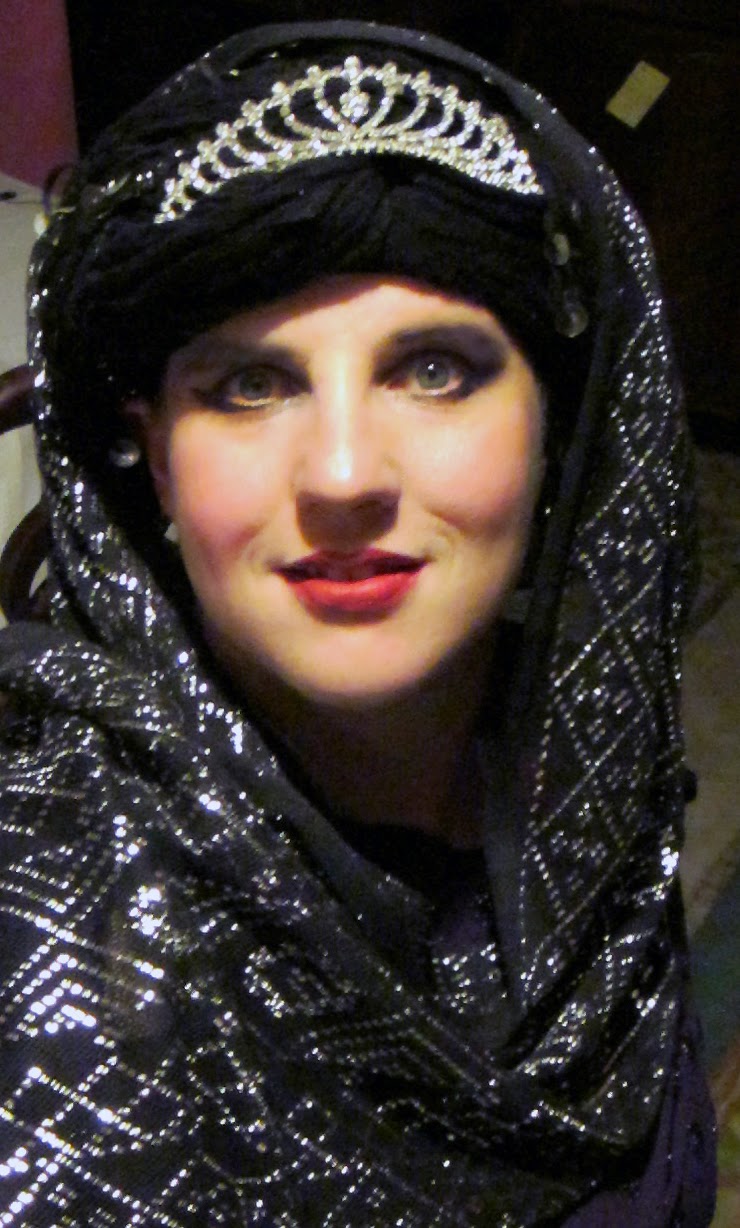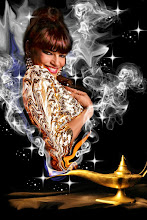 |
| Assiut Queen Dawn Devine aka Davina: Photo by Alisha Westerfield |
Quite a few dancers can brag
about having a career that spans a
quarter of a century, but not that many of them can also claim concurrent and wildly
successful careers as
costumers, art historians and authors! The multi-talented Davina, aka Dawn Devine can…only thing is, she doesn’t gloat about
it, she’s much too nice – and busy- for that sort of thing.
Easy-going, sweet and funny, Davina is so understated about her vast
accomplishments, that even if you know her, they might surprise you!
Dawn has so many college
degrees, they practically form their own alphabet, and in addition to performing
and teaching belly dancing and costuming classes throughout the USA, she also has
numerous museums show credits. She is an expert on antique textiles (especially Assiut, but more on that in a
minute!) Victorian clothing, and vintage
couture, with many lecturing engagements under her tasseled hip belt. She also
a slew of informative,
instructional costuming books to her credit, including
Embellished Bras, Costuming from
the Hip, From Turban to
Toe Ring, Bedlah, Baubles and Beads and Style File.
 |
| Rayah wears a vintage assiut shawl from the collection of Judeen Esau. This gorgeous piece has a rich blue groundcloth and a golden hue to the metal. Photo by Alisha Westerfeld |
As anyone who knows her can attest,
Dawn is a walking encyclopedia on anything concerning belly dance costuming,
but her favorite subject, and most enduring obsession is Assiut, the gorgeous traditional
net and metal fabric named for the
Egyptian city of the same name. All
belly dancers, no matter what their preferred style, are in love with Assiut. Spotting a vintage piece of Assiut on eBay
causes dancers to bid like maniacs, eager to part with their rent money. Merely mentioning
it on social media causes comments like
“I’m drooling all over my keyboard!” And
in real life, a shawl of vintage Assuit at a flea market has been known to
induce catfights.
Davina’s own Assiut mania began this way:
“My love
story began in a crowded antique store, filled with dusty cases holding tumults
of vintage items. I turned and looked across a crowded room and my life
changed. In an instant the rest of the world disappeared and I only had
eyes for one thing. My love story began in a crowded antique store, filled with
dusty cases holding tumults of vintage items. There were jewelry pieces
and objects d’art. There were trinkets and baubles, the day-to-day objects that
populated the lives of our ancestors, 60, 80, 100 years ago. But there,
draped gently over the edge of a photo frame, and laid delicately across a
shelf was my beauty. She was creamy and soft, with pewter-toned metal
stitches. It was Assiut, and it was going to be mine!”
Since that fateful moment, she’s been hooked
on Assiut, also known as tulle bi telli. It became a hobby, moved into a personal mania
phase, and then, it took over her life! Now, she’s spreading the love- and her
vast knowledge.
Davina’s latest book, done with photographer and belly dancer Alisha Westerfield, The Cloth of
Egypt: All About Assiut was just published. The book is gigantic, highly informative,
impeccably researched, and loaded with incredible vintage photos of Assuit, as well as
step-by-step instructions for
fabricating costumes.
Even before the book was a glimmer in her eye, Davina spent years researching Assuit, not to
mention fabricating high-end, custom-made costumes for herself and many other
dancers.
She says,
“I
committed myself to a massive interdisciplinary research project with one
simple mission, find out everything there
is to know about the cloth we call Assiut or tulle bi telli. The
result of years of research, months of writing, crafting hundreds of costumes,
dozens of photo shoots, is my new book “The Cloth of Egypt: All About
Assiut.”
In honor of the book’s publication,
Davina has complied a list of facts on Assiut
exclusively for this blog, here it is:
1 - Assiut is made from cotton. Frequently, antique Assiut is labeled
as silk, linen, or a blend, but the truth is that vintage Assiut cloth is made
from finely spun, high-twist Egyptian cotton.
2 - Assiut can be spelled in a myriad of ways. Arabic cannot be
easily translated, so rather, it’s transliterated by ear from spoken Arabic to
written English, with British and Americans sounding out the words and writing
them down phonetically. This leads to more than 50 spelling variations.
3 - Most people know that the phrase tulle bi telli means “mesh with
metal”... but few know that this is a marriage of three languages. Tulle is
from the name of the lace-making capital of France. Telli is from Turkish
word Tel, which means metal. Bi is “with” in Arabic.
4 - Assiut is a single-stitch embroidery technique. The stitch is
made with flattened metal wire called plate, and the stitch is made using a
blunt tipped double-eyed needle.
5 – Antique Assiut cloth was made by the thousands of yards and was
considered the essential souvenir for travelers down the Nile during the
British occupation of Egypt. British, American, Russian, French, And
Italian women all collected and coveted Assiut cloth for it’s supple drape and
metallic gleam.
6 - Vintage Assiut pieces come in three sizes. Scarves, narrow enough
to wrap around the neck, head or hat to keep flies, gnats and mosquitos off of
the face. Shawl sizes, which were designed to be worn as wraps about the
shoulder, were wide enough to envelop the body, but short enough to be easily
handled by the wearer. Opera wrap or piano shawl size, which was the
longest and widest, designed to fit over a grand piano, or to wrap around the
body, and still have enough left to elegantly drag along the ground, a
shimmering train of exotic abundance.
7 - Modern Assiut should be pounded or rolled to press down the individual
stitches. Machine wash on gentle and tumble dry low in a mesh lingerie
bag to keep the stitches from catching, and pulling. Vintage Assiut
should always be hand washed and dried as flat as possible.
8 - Assiut is associated with weddings in Upper Egypt. Some of the most
popular motifs are directly related to wedding symbology. Camel figures with
plants, stars, or even stylized men, represent the groom. The female
figures, often holding hands, or with arms raised, represent the bride and her
bridal party. Other common images that appear in Assiut wedding shawls
include combs, for preparing the brides hair, perfume bottles for anointing her
body, and diamonds, protective shapes with talismanic properties to protect the
bride on her special day.
#
Purchase a copy of “The Cloth
Of Egypt: All About Assiut” here:
 |
| The book's cover: I'm wearing an Assiut bra made by Davina & a pre-1919 white Assiut shawl Photo by Alisha Westerfield |












No comments:
Post a Comment